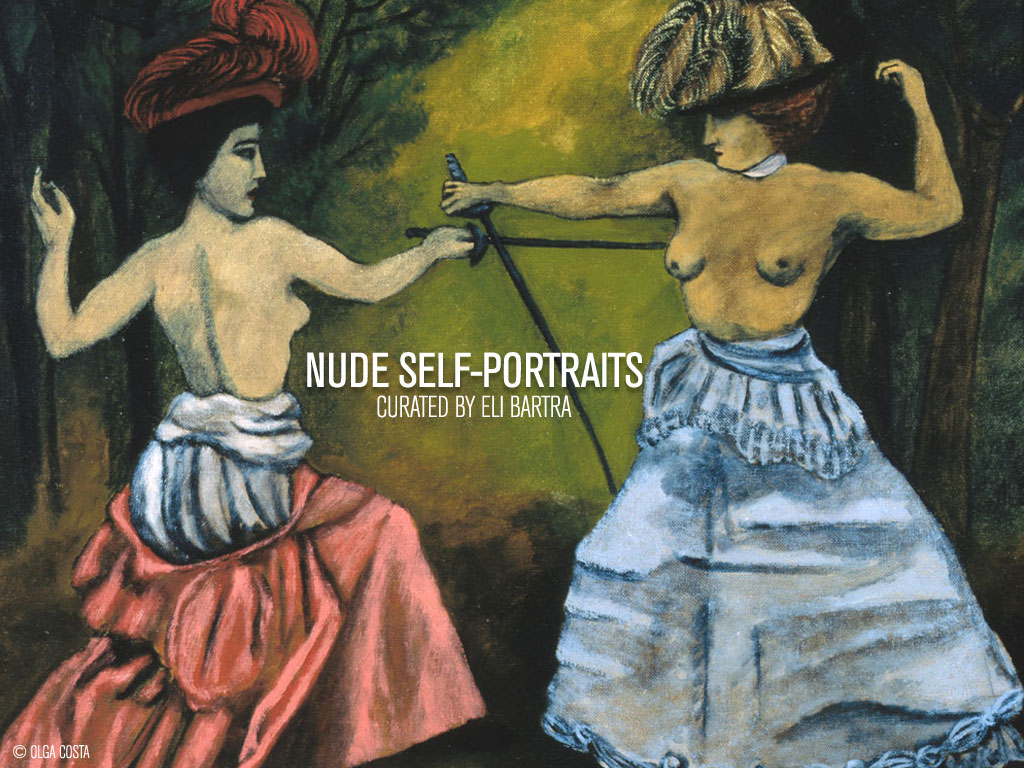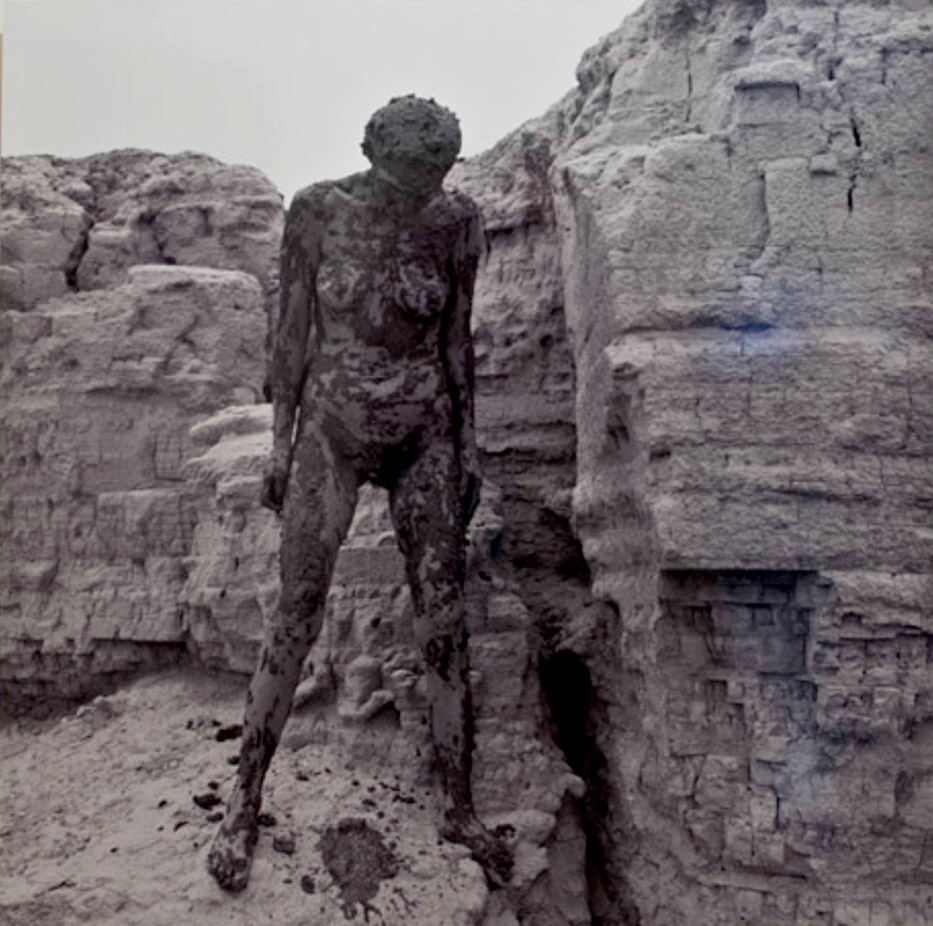Nude Self-Portraits

NUDE SELF-PORTRAITS
by Eli Bartra
Twentieth century artists depicted their naked body increasingly often, and in a variety of manners. If portraits in art represent the identity of a person, the self-portrait is identity itself; however, self-representation involves both identity and self-perception.
Women’s bodies were the center of focus in 1970s feminism. Today, though formal politics and the insertion of women into that space have become the most important aspects for feminism, artists have placed the female body in another dimension: denouncing all forms of violence against it. At the same time, the female body is shown as violated and lacerated, and used as an artistic denunciation of many other social abuses.
From the 1960s onwards, various forms of rupture emerged in Mexico, including the 1968 student revolt. The so-called rupture movement in art occurred precisely during this period, though it had begun in the previous decade, principally struggling against the dominant, well-established Mexican school of painting spearheaded by three legendary artists: Rivera, Orozco, Siqueiros and subsequently Tamayo.
The early 1970s saw the appearance of Mexican neo-feminism, within which female artists carried out a series of ruptures. One of these is the representation of the naked female body - often their own – using methods significantly different to those that prevailed in the canon, with the exception of artist such as Frida Kahlo, who broke away in her own manner.
The depiction of the nude body is inevitable linked to eroticism and pornography, and though neither erotic art nor pornographic art have yet been fully defined, both can be redefined repeatedly, since we are a long way from arriving at a consensus.
Lynda Nead, paraphrasing Kenneth Clark, writes that they are very different things, noting that "As soon as an image becomes an 'incentive for action’, it is expelled from the sphere of art and creativity, and enters the inferior, corrupted domain of the documentary, propaganda and pornography." (Nead, 1998, p.50). I do not agree with this statement, as there are numerous examples of critical, politically committed art that can inspire one to act, and yet are not pornographic.
The depiction of a naked body is fundamentally erotic, and a clearly exposed representation of the sex, a subject with an erection or explicit sexual relations tend to be pornographic, and appear frequently in the art history of any country. If this depiction is aesthetic, it will be art; if not, it is merely pornography, although the context is obviously crucial. What is erotic at one moment for one person may not be so at another time or for a different person, both in art and daily life. Cassidy Hughs writes that “The painting of the female nude in 'great art', as an image, is very similar to the pornographic image, which offers women as sexualized objects for the lust of men.” (pp. 29, 46 and 86. My translation). Thus, the fine line between erotic art and pornographic art often becomes increasingly blurred. [The author Calvo Serraller speaks clearly of a “pornographic art”, although the majority of critics do not acknowledge its existence. (1998, p. 297).] It would arguably be more relevant to speak of the erotic or the pornographic in art.
I will propose a small sample of self-representations by 20th and early 21st century Mexican artists. It is significant that I did not find a single one from the 1950s and 1960s. This is perhaps because those decades were the heyday of abstract expressionism.
All these images, almost without exception, are moving, dynamic, forceful, challenging self-representations, and extremely striking. Another aspect worth noting is artists’ frequent use of fluids such as milk and blood, predominantly women’s. They also utilize mud, another female element that refers to the glorious "Mother Earth." Numerous artists, both male and female, depict their bodies in a fragmented manner. Although artists in the past often did this, it is an intriguing aspect of the self-representations. Is it a form of criticism, or a way of expressing the fragmentation often experienced by women, the “broken woman”?

Nahui Olin. Self-Portrait, Oil. c1929.
In one of her numerous self-portraits, Nahui Olin (1893-1978) paints herself as young and beautiful, but though she poses for herself and looks directly at the camera, she is in movement.

Olga Costa, Duel, 1942.
Olga Costa, (1913-1993), like Frida Kahlo’s 1939 painting The Two Fridas, represents two forms of herself fencing. It is much more externally active than Kahlo’s work, since in Frida’s painting, the action merely takes place on the inside, emotionally.

The Broken Spine by Frida Kahlo, Oil on canvas, 1944.
The Broken Spine by Frida Kahlo (1907-1954), depicting a lacerated, martyred body, arguably contains erotic features, as the firm breasts may be considered erotic… again, by certain persons.

Chela Cervantes, s/t, watercolor / paper, c1975.
The untitled watercolor by Chela Cervantes (1954-) painted in naif style in the 1970s, in which she is lying on a canopy bed, spreading her legs and showing her sex, is also a clearly erotic, provocative work, produced at the height of the artist’s feminist phase.

Pola Weiss, Exoego, video, 1981.
Meanwhile, Exoego by Pola Weiss (1947-1990) is one of the few videos in which she herself is naked. She is depicted dancing, wrapped in a cloth and surrounded by cloths, that intrinsically female object.

Lorena Wolffer, Báñate, performance, 1992.
Lorena Wolffer (1971-) is a performance artist and a key element in her works. Frequently appearing naked, she offers a critical undressing of Mexican reality. Take a Bath, from 1992, was her first performance. “In this ritual,” she states, “I sought to subvert the typical interpretation of blood, both in the history of performance and in everyday life, as an element of shock, and instead use it as a purifying, erotic substance."

Helena Neme, Open Map, pinhole, 2007/8.
In the image by Helena Neme (1974-), created using a pinhole-camera, a fractured body appears that is both fragmented and eminently erotic.

Mónica Mayer, “Mater 6”, drawing, 1997.
Mónica Mayer (1954-), one of the first artists in the neo-feminist movement, has produced feminist art for over 40 years. In this drawing, in which she appears to be pregnant, she depicts herself as headless and with no legs below the knee. As I already mentioned, it is curious that feminists in particular tend to create partial or split nudes or nude self-portraits.

Gladys Villegas, Girly Territory Series (triptych), digital graphic, 2010.
Gladys Villegas (1961-) is another artist who depicts herself as divided, or partial. Her heavily veiled body attempts to show itself but does not actually do so.

Lucero González. Photography. c1997.
In Connect, from 1997, Lucero González (1947) depicts herself in a ritual, cakes herself in what appears to be mud and earth, and meditates, naked before her camera at the age of 50, in a deeply transcendental pose that does not accurately represent her.

Eugenia Vargas. Untitled, 1985/1986
Eugenia Vargas (1949) also plays with mud in the series Untitled, from 1985/1986, in the midst of a wild, rocky nature, and covers herself in mud, blending into Nature like a chameleon and wearing a despondent expression.

Susana Chaurand, “Self Portrait with Roses, Tepic”, Photography, 1994.
Susana Chaurand (1955-2012) lies in an almost fetal position in Self-Portrait with Roses, Tepic, from 1994, and covers herself with a transparent black cloth, as though she were a membrane of the uterus. The cloth blackens her very pale body, and she has her eyes closed. It is a sort of birth-death.

Ana Casas Broda, Three Days After the Birth of Lucio, 2008. From Kinderwunsch Book. 2006-2012. Editorial La Fábrica
Three Days After the Birth of Lucio, created in 2008 by Ana Casas Broda (1965) is a strange photograph, because she appears to be pregnant but the baby has already been born and is clinging to her breast. The child seems to float, as the artist is holding one of her arms behind her head and the other one next to her body.

Maru de la Garza, Performance. Female Episode, 2005.
Maru de la Garza (1961-) also plays with her naked body to show us a divided female body bathed in milk.

Luisa Restrepo Moreno, performance La Pocha Nuestra workshop, 2010. Photo by Antonio Turok.
Performance artist Luisa Restrepo Moreno (1977) seeks to make viewers uncomfortable by using her unclothed (although not naked) body in the workshop La Pocha Nuestra (Our Chicana). She is covered in charcoal, and another woman is licking her body at length, for 20 minutes, like an animal. There is undoubtedly a close relationship between the two bodies.

Colectivo Doble A. Adriana Bravo and Andrea Robles, Self-Portrait, 2012.
Another interaction of bodies takes place in the Colectivo Doble A (Adriana Bravo and Andrea Robles), which also shows the inside of their bodies, including their skeletons. One of them has full access to the inside of the other, and plays her like a piano.

Bela Limenes, Photo, From the series Even the Poren, 2010-11.
Photographer Bela Limenes (1959-) depicts herself removing her clothes, showing yet not showing. This act is often extremely sensual, as is the case here, but it is also rather casual and mundane. This is another partial body, showing a woman’s most sexual features, her breasts and pubis, which she manipulates as she sees fit.

Angélica Escoto, Stories and Hysteria, Self-Portrait, 2008.
The sublimated body of Angélica Escoto, as though it were an image in a painting, is once again split here, in a reference to its interior. Not merely the external but also the inside appearance of the bodies is shown: the entrails and bones.

María Eugenia Chellet, La Maja soy yo, collage, 1988.
María Eugenia Chellet (1948) makes an ironic, critical comment on Goya’s The Naked Maja, in which she herself appears as the Maja.

Patricia Greene, Splendor, copper wire, wood base parota, 2009.
In Patricia Greene’s wire sculpture with autobiographical references, (1952), the woman, also segmented, fades away, escapes or rises up to the sky, towards the immensity of the universe.

In "Rest", 2010, mixed by Sonia Félix Cherit (1961)
In Rest, created in 2010 by Sonia Félix Cherit (1961-), two clay bodies lie in what appears to be a sea of straw. They lack a head, feet and arms, but the female sex lying face up is clearly visible. These are two active bodies, not merely “lying” but instead tense, hard and obviously young. This is a self-portrait.

Yolanda Leal, This is not, Photo, 2002 (Sorry for the inconvenience)
Yolanda Leal (1968) depicts herself defiantly, looking directly at her own camera. She challenges the viewer with her open legs, saying: “I beg your pardon”, boldly revealing her sex to the viewer.

Erika Trejo (1976) “This body is mine”, performance-video Opposite the Teatro Romea, Murcia, 2012.
In this feminist video-performance by Erika Trejo (1980-), she stands naked carrying a placard stating “this body is mine”, and poses for cameras in the street.